JHP Newsletter - 2009, No. 6, 1 December
Greetings from Pancho Villa State Park, New Mexico.
Equipment: Lee Filters Foundation Kit
I purchased a used Lee Filters Foundation Kit and a new 77mm adapter for wide-angle lenses. I look forward to using the holder for my 4-inch filters in the field.
I took some test shots with my Canon EOS 1Ds Mk III (full frame sensor) to evaluate vignetting with my wide-angle lenses, with and without a B+W F-Pro circular polarizer mounted to the lens in front of the Foundation Kit. Here's a summary of the results. For the Canon EF 24-105mm f4 L IS USM at 24mm, it looks like there will be no problem using the Foundation Kit without a polarizer for most landscape work because I would usually shoot it at at least f11. With a screw-in polarizer attached between the lens and the Foundation Kit attached to it, then I'll have to compose 4x5-aspect-ratio images. For the Canon EF 16-35mm f2.8 L USM (the Mk I version) at 16mm, it looks like there will be no problem using the Foundation Kit without a polarizer for most landscape work because I would usually shoot it at at least f11. With a screw-in polarizer attached between the lens and the Foundation Kit attached to it, then I'll have to compose 4x5-aspect-ratio images. For the Canon TS-E 24mm f3.5 L (the Mk I version), with a B+W 72 to 77mm step-up ring attached to the lens first, there doesn't appear to be any vignetting problem at all with no tilt or shift movement.
Here are the detailed results for the Canon EF 24-105mm f4 L IS USM at 24mm. With no filter, there's noticeable vignetting at f4, slight vignetting at f11, and insignificant vignetting at f16. The B+W F-Pro UV filter, that's usually attached when no other filter is attached, increased vignetting ever so slightly. Attaching just a B+W F-Pro circular polarizer gave results similar to having just the UV filter, but there was still slight vignetting at f16. Then I attached just the wide-angle adapter to the circular polarizer because I had planned to keep using my screw-on polarizer with the Foundation Kit. The wide-angle adapter was visible in the corners at all f-stops tested, so using a circular polarizer between the lens and the Foundation Kit will only work if I crop the images to a 4x5 aspect ratio. Attaching the Foundation Kit didn't change the vignetting. Then I took off the circular polarizer and attached the wide-angle adapter directly to the lens. There was no noticeable change from the lens-only shots. Attaching the Foundation Kit increased vignetting slightly at f4, but there was no noticeable difference by f11.
Here are the detailed results for the Canon EF 16-35mm f2.8 L USM (the Mk I version) at 16mm. I tested it using the same sequence as the 24-105. The B+W slim UV filter increased vignetting compared to just the lens at f4, but any noticeable difference was gone by f8. I took off the UV filter and put on the B+W F-Pro circular polarizer. I would normally use a B+W slim circular polarizer, but it doesn't have threads on the front of it (that's how it gets to be "slim") and I wanted to evaluate a "waterfall setup" — polarizer and neutral density filters in the Foundation Kit. The filter produces dark corners up to f16, so images would have to be cropped to 4x5 (full width) or trimmed slightly in 2x3. Adding the wide-angle adapter to the polarizer increases the size of the dark corners, but a full-width 4x5 crop would remove them. Attaching the Foundation Kit didn't change the images. Then I removed the circular polarizer and attached just the wide-angle adapter. That configuration worked better than with just the UV filter attached. Adding the Foundation Kit didn't change the images.
Here are the detailed results for the Canon TS-E 24mm f3.5 L (the Mk I version). I tested it using the same sequence as the 24-105, and all images were taken with no tilt or shift. There was some vignetting with the Hoya UV filter at f4 and f5.6, but it was gone by f8. The same effect was seen without any filter at all. Next I attached a B+W 72 to 77mm step-up ring and the same B+W F-Pro circular polarizer that was used for the other lenses. This is how I plan to use the Foundation Kit because I currently only have the one 77mm adapter ring. The results with the stepped-up polarizer were the same as with no filter. Then I attached the wide-angle adapter to the polarizer, and that gave me the same results again. Adding the Foundation Kit didn't change the images either. So, it looks like this will be a workable combination for future shooting. Of course, vignetting might start sooner when tilt and/or shift is applied with those attachments than without them. I also ran the sequence of shots without the circular polarizer, and not surprisingly, they were the same as without any filter too.
Travel: Alaska
Way back at the beginning of September, we went to Homer, Alaska, to go on some bear viewing flights with Ken and Chris Day of Emerald Air Service. I had gone out with them on my previous visits to Alaska, and Jan had met them before but wasn't able to go out with them due to a weather cancellation. On one of the days in Katmai National Park and Preserve, we sat on the bluff overlooking the confluence of Moraine Creek and Funnel Creek, and watched and photographed a brown bear sow and cub (below left). On another day, we were down on the shore of Moraine Creek, and spent some nice time with a brown bear fishing (below right). Ken and Chris are great guides and great people, and we had dinner with them after our last bear flight with them. It was their last flight of the season, and we found out the next day it was their last flight ever — they were shutting down Emerald Air Service — a sad day.
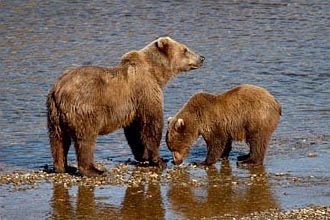
1/500 sec, f8, ISO 250
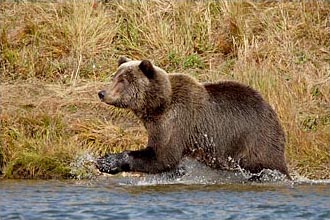
1/1000 sec, f8, ISO 400
We returned to Wasilla and stayed at our friends again for a few days in the middle of September. We went to Hatcher Pass again, and the pika and Arctic ground squirrels weren't too exciting, but we had lots of fun photographing the Little Susitna River with some fall color (below left). I used one of my new HiTech neutral-density filters in addition to my old Hoya screw-on neutral density filter to help blur the water more than I could in the past.
We left Wasilla and started making our way back to the lower 48. The fall color in the Matanuska valley was spectacular, but the light wasn't very exciting to photograph it as we were going through. We did stop to photograph a very nice rainbow (below right), though. It was one of the best rainbows I've ever photographed: it stayed around for along time, and there was no rain where we were. :)
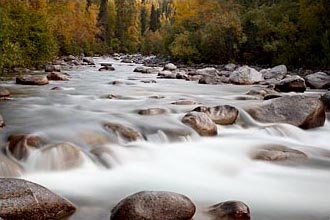
polarizer, ND, 10 sec, f11, ISO 100
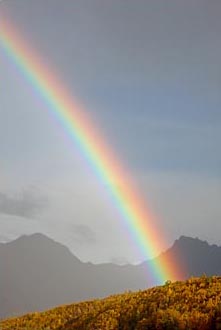
Alaska, USA
polarizer, 1/30 sec, f11, ISO 100
Travel: The Alaska Highway
We crossed over into Canada in the middle of September and started our way back down the Alaska Highway. We stayed at Muncho Lake Provincial Park, British Columbia, again, but the stone sheep didn't come out to play this time. We were able to get some nice images of the woodland caribou though.
We left Muncho Lake and stopped for lunch at the Toad River Lodge. Their blueberry pie was the best I've ever had! After lunch, we photographed the fall colors on the hillside behind the lodge (below left). The polarizer was useful to reduce the glare off of the wet leaves and bring out more of the natural color.
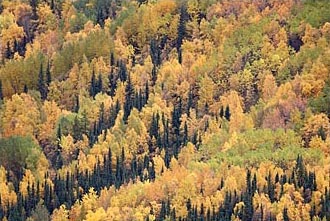
British Columbia, Canada
1/10 sec, f11, ISO 100
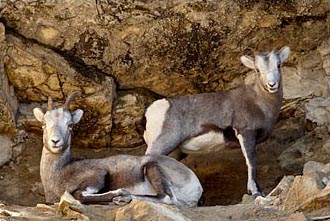
British Columbia, Canada
1/125 sec, f8, ISO 400
Then we stayed in Stone Mountain Provincial Park, British Columbia, and the stone sheep were slightly more cooperative than last time. One morning, a ewe and lamb were down near the road when we arrived. By the time we pulled off the road and got ready to photograph them, they had climbed up the cliff. After a while, the ewe went into a small alcove, and then the lamb joined her (above right). :)
Travel: Jasper National Park, Canada
We spent five nights in Jasper National Park, Alberta, at the end of September. The elk were rutting near the Jasper town site, and we watched a spectacular fight between two bulls one afternoon (below left). They went at it for more than 15 minutes! One afternoon, we hiked up the hill behind Old Fort Point to photograph a bighorn sheep ram. He was quite used to people walking along the path near him, and he was very cooperative (below right).
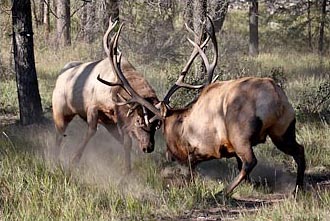
1/750 sec, f8, ISO 400
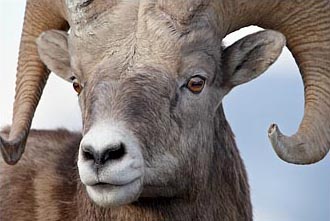
1/250 sec, f8, ISO 400
We photographed the bighorn ewes and lambs near Talbot Lake a few times. My favorite image (below left) was taken with a much shorter lens (24-105 at 105mm) than I usually use for wildlife (500mm, and usually with a 1.4x II tele-extender) so I could include more of the environment. Jan was also using her 24-105 (I actually got the idea from her), and that ewe was very comfortable with us. The rest of the sheep had crossed the highway, and a concerned young man came striding over to us to let us know that it wasn't good to cut off one goat (yes he said "goat") from the rest of the group, yadda yadda yadda. Jan thanked him for his concern, and he left. The ewe in question hadn't been blocked off from the rest of the group, and she had only been nervous when the helpful young man came striding over to us — bloody idiot!
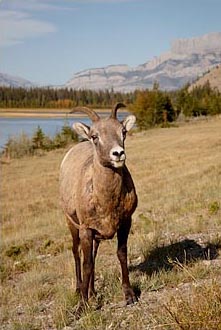
24-105 (at 1052mm),
1/350 sec, f11, ISO 125
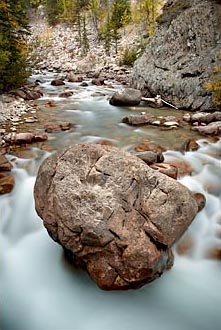
24 TS, polarizer, ND,
20 sec, f11, ISO 100
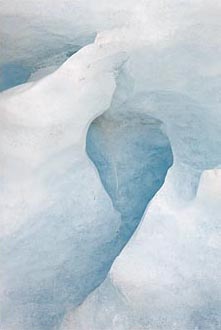
Athabasca Glacier
100-400 (at 285mm),
1/20 sec, f11, ISO 100
The weather was more conducive for landscape photography on this stop than in June. My favorite image is of a huge boulder in the Astoria River (above center). Once again, I used one of my new HiTech neutral density filters in addition to the screw-on Hoya neutral density filter to really increase the length of the exposure.
It was while photographing along the Whirlpool River that I decided I needed a filter holder for my 4x4-inch (100x100mm) solid neutral-density and soon-to-be purchased 4x6-inch (100x150mm) graduated neutral-density filters. I was hand-holding a 4x4-inch neutral-density filter and an 84x120mm split neutral-density filter in front of the lens while squatting on boulders out in the river, and I got quite tired after several back-to-back 20- to 30-second exposures. Plus, a holder will make it easier to position the transition in the graduated neutral-density filter so it will be consistent over several exposures while fine-tuning the exposure or trying different solid neutral density filters or different degrees of polarization.
We spent one night camped at the southern end of Jasper National Park so we could revisit Tangle Falls. I wanted to re-take a composition I had photographed in June, but with more neutral density this time. The falls looked quite different with less water flowing, so that composition wasn't very interesting. I was able to capture some other interesting images, though.
We went to the face of the Athabasca Glacier one afternoon, and had a great time photographing the various ice formations there. My favorite is of a "comma" (above right).
We had been planning to spend time in Banff National Park, but the weather forecast was for mostly rainy days, so we just drove through the park on our way south.
Travel: Grand Teton National Park, Wyoming
We went through Yellowstone National Park in early October, and stopped to photograph some of the thermal features. We spent two nights in Grand Teton National Park at the Gros Ventre Campground. There was a group of pronghorns just outside the campground the first morning, and we were able to get some nice shots of the buck (below left) keeping an eye on his harem. The most exciting wildlife we saw was a bull moose. We first saw it far from the road by the airport. He was making his way towards the road, so we stopped and waited. He came up very close to us before crossing the road, and the snow on his antlers was a nice touch (below right).
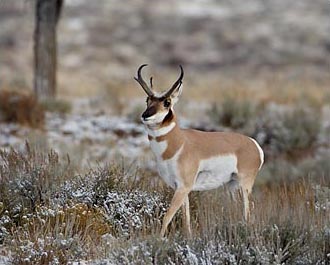
1/750 sec, f8, ISO 400
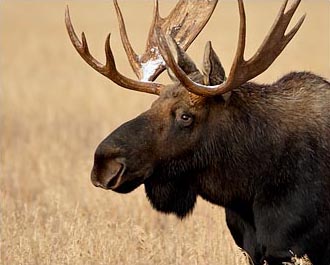
1/350 sec, f8, ISO 400
Travel: New Mexico
We spent two nights at the beginning of November at Cochiti Lake Recreation Area, a US Army Corps of Engineers facility near Kasha-Katuwe Tent Rocks National Monument. The Tent Rocks are cone-shaped hoodoos. They're unique because the layers of rock below the capstones are composed of volcanic pumice, ash, and tuff, whereas most hoodoos are formed from sedimentary rock. Jan had wanted to go there for a long time, but I wasn't too impressed by the photos of the place by other photographers — it didn't look like it would be too photogenic. I was pleasantly surprised that it was an interesting area that was in fact photogenic.
Then we went to Elephant Butte Lake State Park, near Truth or Consequences, for fourteen days. It's one of our favorite parks, and it's great for doing office work. All of the sites in the South Monticello Campground have electric hookups, so there's no concern when running our computers and external hard drives all day long. Plus there's a good Verizon Wireless Broadband internet signal, and the campground is quiet! There's not much to photograph there either which makes it easier to get office work done. We had some nice sunsets while there, including one with some really intense orange color (below left).
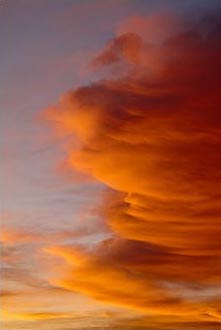
New Mexico, USA
100-400 (at 100mm),
1/15 sec, f11, ISO 100
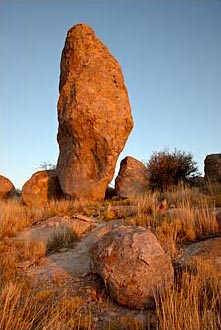
New Mexico, USA
24-105 (at 28mm),
1/10 sec, f11, ISO 100
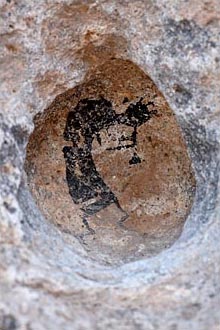
New Mexico, USA
180 Macro, 580EX flash,
1/8 sec, f11, ISO 100
In mid October, we spent four nights at City of Rocks State Park, in the southwest corner of New Mexico. It was our first time there, and we thoroughly enjoyed it. The big draw is the many huge rock boulders that are clustered throughout the park, and we had fun photographing them (above center). There are also several pictographs and petroglyphs, including two Kokopelli (above right). I used a flash handheld just below the 180 Macro to help illuminate the pictograph that was in a small alcove.
The park is popular with amateur astronomers because it's far from any city lights. The campsites have numbers like usual and also names based on constellations and other celestial features. We stayed in "Camelopardalis," and I just love the name. It's the Greek word for "giraffe" — they thought giraffes had the head of a camel and the body of a leopard. :) It's also part of the (Latin) scientific name for a giraffe: Giraffa camelopardalis.
Travel: Arizona-Sonora Desert Museum, Tucson, Arizona
At the end of November, we went to Tucson and camped on some BLM (Bureau of Land Management) land for free not too far from the Arizona-Sonora Desert Museum. We first visited the museum about a year ago, and we wanted to return before our membership expired. The term "museum" is a bit of a misnomer because it's more like a zoo and botanical garden — almost everything's outside instead of being in a traditional museum building. Our last day to visit the museum was Thanksgiving Day, and that was a great day to visit — there was hardly anyone else there!
One of the nice things there, especially for photographers, is that docents are stationed throughout the museum holding raptors. We were able to photograph an American kestrel, Harris's hawk, and a western screech-owl (below). The desert bighorn sheep ram was following one female all around the enclosure hoping that she was ready to mate. He's demonstrating the flehmen response in the image below right. The flehmen response is a particular type of curling of the upper lip to facilitate the transfer of pheromones and other scents to their vomeronasal organ. In males, it's usually associated with mating season because it helps them sense when females are ready to mate.
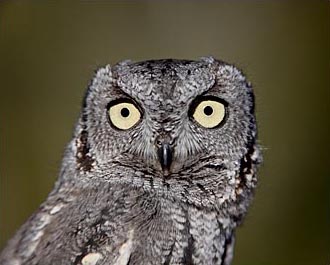
Tucson, Arizona, USA (captive)
1/500 sec, f8, ISO 200
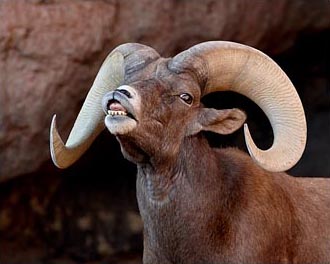
Tucson, Arizona, USA (captive)
1/150 sec, f8, ISO 400
One of my favorite animals to photograph in the museum is the river otter. It's usually a bundle of energy swimming around the pond in its enclosure, but one morning it was sleeping next to the pond and sucking on its tail (below left). I had never seen anything like it! Another favorite of mine is the reptile house where they have, among others, Mexican boa, hypomelanistic kingsnake, Arizona mountain kingsnake, Arizona black rattlesnake, hypomelanistic western diamond-backed rattlesnake (below right), northern Mojave rattlesnake, speckled rattlesnake, and Sonoran desert sidewinder.

Tucson, Arizona, USA (captive)
1/90 sec, f8, ISO 640
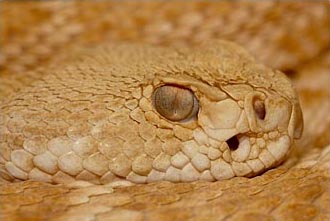
Diamond-Backed Rattlesnake
Tucson, Arizona, USA (captive)
580EX II and 550EX flashes,
1/90 sec, f9.5, I SO 400
Take care and happy shooting.
— James
James Hager Photography :: www.jameshagerphoto.com




